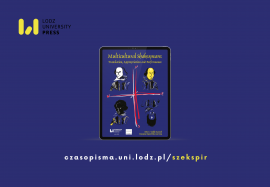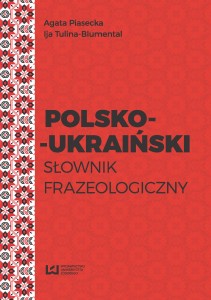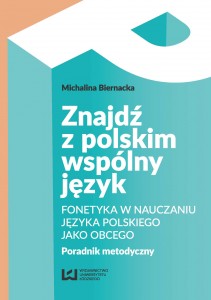Multicultural Shakespeare: Translation, Appropriation and Performance | Vol. 26, No. 41 (2022): Shakespeare and Utopia
Opublikowano: 24 lipca 2023

Multicultural Shakespeare: Translation, Appropriation and Performance jest periodykiem o zasięgu międzynarodowym, poświęconym studiom szekspirowskim. Od 2003 wydawany jest przez Wydawnictwo Uniwersytetu Łódzkiego, red. Yoshiko Kawachi, Krystyna Kujawińska Courtney. Wcześniej, tj. od 1972 ukazywał się jako Shakespeare Translation; od 1986 jako Shakespeare Worldwide: Translation and Adaptation, red. Yoshiko Kawachi.
Od początku istnienia, Multicultural Shakespeare wzbudzał zainteresowanie badaczy z różnych zakątków świata, z czasem stał się istotną publikacją z zakresu studiów szekspirowskich o zasięgu międzynarodowym. Pierwotnie poświęcony głównie przekładom, przekształcił się w periodyk, zajmujący się adaptacjami/przywłaszczeniami tekstów Szekspira, nowymi odczytaniami i inspiracjami jego dziełami.
Multicultural Shakespeare: Translation, Appropriation and Performance stanowi forum, dzięki któremu naukowcy, zwłaszcza pochodzący z krajów nieanglojęzycznych, mogą analizować lokalne zagadnienia, przyczyniając się tym samym do zrozumienia Szekspira jako globalnego fenomenu. Periodyk stwarza możliwość spojrzenia na uniwersalny wymiar dzieł Szekspira, wydobywając ich lokalne wartości kulturowe np. australijskie, brazylijskie, chińskie, finlandzkie, francuskie, niemieckie, greckie, izraelskie, japońskie, koreański, polskie, rumuńskie, rosyjskie, hiszpańskie, czy też amerykańskie i brytyjskie. Istotnym elementem w publikacjach jest ontologiczne i międzykulturowe znaczenie dzieł Szekspira.
Artykuły dostępne w języku angielskim.
Punktacja MEiN: 100 punktów (lipiec 2023)
“To Make Dark Heaven Light:” Transcending the Tragic in Sintang Dalisay
Anne Nichole A. Alegre
Directed by Ricardo Abad and choreographed by Matthew Santamaria, Sintang Dalisay—a Filipino adaptation of Shakespeare’s Romeo & Juliet—is often lauded for its use of the igal ethnic dance of the Sama-Badjau, a Muslim tribe located in the southern region of the Philippines. It depicts Rashiddin and Jamillia’s star-crossed love amidst a violent and ancient feud between their families. This paper discusses the process and product of interweaving performance traditions and cultures in Sintang Dalisay and how the adaptation transforms Shakespeare’s Romeo and Julietfrom tragic to utopic. It does so in two aspects: the kinesthetic and the mythic. First, the use of the igal dance motif expresses and unearths the play’s inherently religious and celestial language. Second, the appropriation of Asian myths or beliefs—particularly of Chinese and Filipino origins—transforms and transcends the tragic ending of Romeo and Juliet’s deaths.
“Hopeful feeling[s]:” Utopian Shakespeares and the 2021 Reopening of British Theatres
Rowena Hawkins
This article focuses on a specific moment in recent British theatre history: the late spring of 2021 when theatres reopened after a prolonged period of closure that had been enforced during the first waves of the Coronavirus pandemic. It considers The HandleBards’ production of Romeo and Juliet (performed at York’s Theatre Royal) and Shakespeare’s Globe Theatre’s production of A Midsummer Night’s Dream in the context of that unusual time. The productions, which both used bright colours and irreverent approaches to create festive atmospheres, had a shared joyful aesthetic which encouraged me to think more deeply about what audiences wanted—and needed—from post-lockdown theatre. In this article, I suggest that these vibrant Shakespeares, when presented in the immediate aftermath of the first waves of Covid, functioned as cathartic utopian performatives. They offered audiences uncomplicated joy and “a hopeful feeling of what the world might be like” after Coronavirus (Dolan 2005, p. 5). They “let audiences experience a processual, momentary feeling of affinity” and encouraged them to “imagine, together, the affective potential of a future in which this rich feeling of warmth, even of love, could be experienced regularly and effectively outside the theatre” (Dolan, p. 14). Utopian performatives are characterised by their transience and, inevitably, the simple joy of these Shakespeares was fleeting. Both venues have since hosted visually and thematically darker productions that have used Shakespeare to explore important social and political issues. Indeed, the HandleBards’ Romeo and Juliet and The Globe’s Midsummer are productions which might, in other circumstances, have been dismissed as simplistic. However, I suggest that these productions offered real hope for the future in the wake of crisis and demonstrate the importance of theatre in challenging times.
Transformative Potential and Utopian Performative: Postdramatic Hamlet in Turkey
Sibel İzmir
Turkey is among those Non-Anglophone countries which have had a keen interest in Shakespeare and his plays for over two hundred years. When it comes to the staging of Shakespeare in Turkey, especially when protagonists or leading roles are considered, “overacting” is one of the most notable techniques highlighting, presumably, the spirit of the Renaissance and Jacobean times. Still, in recent years, there have been some productions which try to challenge and deconstruct the traditional ways of staging a Shakespearean play. One of such productions is Hamlet of Istanbul State Theatre, directed by Işıl Kasapoğlu in 2014, in which the director makes use of postdramatic theatre techniques. As the play begins, the audience sees a huge red jewel box which has been placed onto the centre of the stage. Soon after it is opened, it becomes clear that the character coming out of the box is playing and enacting not only the role of Hamlet but also many other roles in the play. Disrupting the habitual Shakespearean staging which heavily relies on mimesis in a closed “fictive cosmos” (Lehmann 22), the production, more strikingly, allows for an innovative Shakespearean acting as an innovative Shakespearean acting possible as the actor acts out all the major roles, such as Hamlet, Claudius, Gertrude, Ophelia, Polonius, etc., in such various ways as holding dummies in his hands and enacting their roles in monologues and dialogues. Fusing Hans-Thies Lehmann’s theory of postdramatic theatre with Jill Dolan’s argumentation on utopian performative, this study will investigate how postdramatic theatre techniques challenge the traditional Shakespearean performance and contends that postdramatic theatre techniques used in Kasapoğlu’s Hamlet contribute to the utopian performative and the possibility of creating a utopian impulse in the audience. The paper thus will claim that postdramatic performance of Hamletrenders a utopian performative possible by presenting a transformative potential in the audience members which engages in our present moment.
From Race and Orientalism in A Midsummer Night’s Dream to Caste and Indigenous Otherness on the Indian Screen
Archana Jayakumar
The article discusses an Indian film adaptation of William Shakespeare’s play A Midsummer Night’s Dream entitled 10ml Love (dir. Sharat Katariya, 2012). There is little scholarship on 10ml Love, which has been studied mainly as an independent film in Hinglish that depicts the lives of the cosmopolitan youth in urban India. Drawing upon recent readings of the play that identify elements of racism and whiteness as well as an analysis from an Orientalist lens that sees India as a gendered utopia, I suggest that the film adaptation highlights not racial/white supremacy but caste supremacy; furthermore, it indulges not in Orientalist tropes but tropes of indigenous Otherness based on religion, gender, caste, and class. I argue that this film presents two opposing political utopias—a right-wing utopia that stands for the maintenance of traditional values and a left-wing utopia that attempts to challenge, question, and subvert the conservative order. However, 10ml Love seems to endorse neither of the two utopias wholly; its reality appears to lie between the two utopias, a reality that is marked by stereotypes of Otherness. This paper analyses the audio-visual depiction of the tension between the utopias at both the ends of the political spectrum, as well as the realities of Otherness created by the presence of various social locations and identities in Indian society.
Staging Dystopian Communities: Reimagining Shakespeare in Selected English Plays
Michał Lachman
Among the countless afterlives of William Shakespeare’s playwriting there is a strong presence of his visions of state and political powers. In universal, philosophical ways Shakespeare was addressing issues concerning the state power, social organization, hierarchy, and rank in what inevitably were the origins of modern, capitalistic societies. Therefore, many of his powerful images resonate today in the works of contemporary writers who intend to compose stories of utopian or dystopian character which diagnose the condition of modern society. This article aims to present three plays by post-war English dramatists (Edward Bond’s Bingo, Frank McGuinness’s Mutabilitie, and David Greig’s Dunsinane) which reuse Shakespearian themes, motifs, or characters to build politically contentious and subversive plots within a narrower context of their specific cultures, societies, and historical periods. It is assumed that the Shakespearean legacy the writers engage with is not merely a dramatic text, but a complex cultural structure of accumulated narratives, interpretations, and myths which contemporary dramatists rewrite and recycle. The aim of the article is to show how this multifaceted legacy of Shakespeare’s life and work helps build dystopian visions of contemporary communities or images of state and political justice. In other words, the article intends to analyse ways of visualizing modern societies through the palimpsestic presence of the Renaissance master.
“Nor doth this wood lack worlds of company:” the American Performance of Shakespeare and the White-Washing of Political Geography
John M. Meyer
The paper examines the spatial overlap between the disenfranchisement of African Americans and the performance of William Shakespeare’s plays in the United States. In America, William Shakespeare seems to function as a prelapsarian poet, one who wrote before the institutionalization of colonial slavery, and he is therefore a poet able to symbolically function as a ‘public good’ that trumps America’s past associations with slavery. Instead, the modern American performance of Shakespeare emphasizes an idealized strain of human nature: especially when Americans perform Shakespeare outdoors, we tend to imagine ourselves in a primeval woodland, a setting without a history. Therefore, his plays are often performed without controversy—and (bizarrely) on or near sites specifically tied to the enslavement or disenfranchisement of people with African ancestry. New York City’s popular outdoor Shakespeare theater, the Delacorte, is situated just south of the site of Seneca Village, an African American community displaced for the construction of Central Park; Alabama Shakespeare Festival takes place on a former plantation; the American Shakespeare Center in Staunton, Virginia makes frequent use of a hotel dedicated to a Confederate general; the University of Texas’ Shakespeare at Winedale festival is performed in a barn built with supports carved by slave labor; the Oregon Shakespeare Festival takes place within a state unique for its founding laws dedicated to white supremacy. A historiographical examination of the Texas site reveals how the process of erasure can occur within a ‘progressive’ context, while a survey of Shakespearean performance sites in New York, Alabama, Virginia, and Oregon shows the strength of the unexpected connection between the performance of Shakespeare in America and the subjugation of Black persons, and it raises questions about the unique and utopian assumptions of Shakespearean performance in the United States.
Utopia, Arcadia and the Forest of Arden
Ronan Paterson
In Utopia (1516) Thomas More created a humorous world with a serious purpose. His invented republic was a place where existing conventions and structures did not exist, allowing the positing of alternatives. The creation of alternative worlds which satirise or critique contemporary society is a technique employed by writers in most genres, in most periods and in most cultures. More’s work is interesting for us in this context at least in part because of the likelihood that Shakespeare was familiar with it. When he created The Forest of Arden in As You Like It, for some of the characters there are utopian elements in their experience of that place. But Arden is not only a putative Utopia. Arden also contains elements of the pastoral Arcadia, again drawing upon ancient precedents, but more recently explored by English poets Edmund Spenser in The Shepherd’s Calendar (1579) and Philip Sidney in The Countess of Pembroke’s Arcadia (1593). This article interrogates the use of Utopian and Arcadian elements in the creation of one of Shakespeare’s most complicated plays. Like More’s Utopia its intention is comic. Like Sidney’s poem it is romantic, but unlike both of them it is ultimately about returning to a real world, with new perceptions of who we are, not as a society but as individuals.
Contributors
Delilah Bemudez Brataas, Magdalena Cieślak, Anna Kowalcze-Pawlik
Introduction: “With Such Perfection: ” Imagining Utopia through Shakespeare
Delilah Bemudez Brataas, Magdalena Cieślak, Anna Kowalcze-Pawlik
An Interview with Stratis Panourios
Stratis Panourios, Magdalena Cieślak
Book Reviews
Guixia Xie, Sabina Laskowska-Hinz, Ted Motohashi, Jie Tang, Yuying Wang
Theatre Reviews
Takehito Mitsui, Xenia Georgopoulou
Komentarze
Ten post dostępny jest także w języku: angielski





